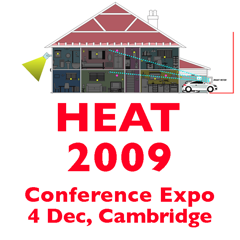| HEAT08 Summary |
| HVMS08 Summary |
| HEAT07 Summary |
| SHIFT07 Summary |
| NANO06 Summary |
| Blog |
| Partners and clients |
09:30-18:00, Friday 19 June 2009
An exciting industrial and commercial business conference expo at which you were invited to contribute to and take away knowledge and contacts on:
Future infrastructure; Network integration; Securing the base load;
Smart grids; Last mile technologies;
Green technology: Solar, wind, wave, tidal, biomass generation; the role of nuclear;
Energy diversity strategy and investment approaches of global players; Policy analysis;
| Cleanpower 2009 | ||
| Registration | ||
| Speaker | Company | Title |
| Delegates! | CIR Media | Cleanpower 2009 image gallery Click here |
| Justin Hayward | CIR Strategy | Introduction and Context (VideoCast) (PDF) |
| Mike McCreary | CIR Strategy | Chairman's Introduction |
| Introductory Session | Moderated by Jeremy Nicholson | Energy Intensive Users Group, EEF |
| Lewis Dale, C Eng, Director of Regulatory Strategy | National Grid | Current and Future Grid Infrastructure (VideoCast) (PDF) |
| Barry Hatton, Director Capital Programme | EDF Energy | Network Integration (VideoCast) (PDF) |
| Smart Grid Session | ||
| Hermione Crease, Director | SENTEC | 'Electricity 2.0' - Part One - The Smart Grid |
| Marcian Cirstea, CEO | CRISTAL | Renewables and Integrated Systems (VideoCast) (PDF) |
| Paul Engle, CEO | Enecsys | 'Electricity 2.0' - Part Two - The Key to PV (VideoCast) (PDF) |
| Morning Panel | ||
| Rapid Pitches | Solaraid, EEEGR, CUEN | |
| EXPO and lunch | ||
| Generation Session | Moderated by Hugh Parnell | GEIF |
| Thomas Prock | Marks and Clerk | Power Patents (PDF) |
| Graham Ford, CEO | Heliodynamics | Concentrated Solar Power (VideoCast) (PDF) |
| Andrew Hine, CFO | Trident | Wave Power (VideoCast) (PDF) |
| Michael Evans, CEO | Green Tide | Tidal Power (VideoCast) (PDF) |
| Mark Quinn, CEO | Clenergen | Biomass (VideoCast) (PDF) |
| Final Session | Moderated by Tim Jervis | Cambridge Energy Forum |
| John Tingle, Regional Trade Advisor - East: Environment and Power | East of England International | Clean power and East England (PDF) |
| Michael Fielding | Artemis Intelligent Power | Wind and Efficiency (VideoCast) (PDF) |
| Peter Brun, Head, Gp Government Relations | Vestas | Global Wind Power (PDF) |
| Katrina Landis, CEO | BP Alternative Energy | Alternative Energy Investments (PDF) |
| Distinguished Panel | ||
| Networking reception | ||
Cleanpower 2009 Conference Executive Summary
Cleanpower is one in a coherent series of business conferences. We have come from an environment where people used to talk about alternative energy. They are no longer alternative. They are options within a composite system which will be affordable, secure and become more renewable and in the long run virtually fossil-fuel free. There is a need to discuss the grid system, which is important for resilience of the energy system and in making many new downstream technologies, like battery EVs clean.
Demand for energy will increase at a rate of 1.6% a year for a total of 45% more, in the next 30 years, according to the IEA in 2008.
90% of oil reserves are owned by countries in the Rest of World category, that is, outside the 3 main energy markets of North America, Europe and Asia Pacific. But 77% of consumption of that oil is within those 3 main energy markets.
Energy security (like basic national security) is a very large responsibility for governments (not to mention the absurdity of transporting these heavy, physical reserves to their point of use).
The UK needs a stable, consistent security, cost and sustainability policy, and a much more strategic approach that transcends changes of democratically-elected government.
Policies (subsidies, market interventions) needed from government for wind and other alternative energy (similar to those that enabled exploration by fossil-fuel companies) were basically transitional policies until a suitable carbon price within a cap and trade system is globally in force. For now, we need this balancing to get fair market entry for clean renewable energy against dirty conventional incumbent energy.
The EU trading system may has had too low a price of carbon because of the free allocations or credits to energy companies, a form of corporatism, regulation and de facto protectionism that may not work well in the long run.
The real cost of energy factors in cost of carbon.
Climate change presents really interesting alternative energy business opportunities for energy production companies.
When entering the alternative energy market, large energy production companies need a strategy at top level.
The internal rate of return requirement for alternative energy groups within a conventional (fossil-fuel) energy production company have to meet the same levels, and do so over broadly similar timeframes as for the conventional business.
Expertise in offshore oil could be turned to offshore wind.
The grid needs to move from passive to active.
The ICT needed will be complex compared to the present system; there are billion pound opportunities for ICT system companies.
There will be opportunities around demand side management and system balancing through storage.
Suppliers will need to decommoditise energy, and convert what they offer to value-added services. When they realise the business model arithmetic, they will be unafraid of and able to support large-scale energy-efficiency and energy diversity movements.
There has been a lot of opposition to biofuels, because they can exacerbate food shortages. Biofuels can be done very well, or very badly. An energy production company present was deeply conscious of the sustainability issue. Food prices have gone down so that that issue reduced in media coverage. Sustainability is really important. We should look at water requirements, which land would be used, and fertiliser used. Any of these things not being done right should be a showstopping problem for an energy company considering investment for market entry.
Wind and solar power will continue to grow and will ultimately become large mainstream energy sectors. It was argued that there was no reason why the wind industry shouldn't go the same way as mobile phones and the airline industry as its competitiveness improves.
In China and the US, growth of wind was happening because targets were being taken seriously, and even being modified upwards. The US has a 25% renewables 2025 target, also a short term one of 10% in 2012. It also obtained energy security through extensive fracking in the country.
There has been enough talking about wind power, and the government and other actors should now halve the talk, double the delivery.
The government needs to take a stronger role in guiding local communities.
The real barriers for wind in the UK are in planning, the grid, and even aviation rules.
Freighting blades from Southern England to other continents such as North America does not make sense any more. And the small UK (wind) market is a problem. The market is still small compared to the total wind energy harnessable. This was cited by a wind turbine company as a reason why the UK had become unfavourable as a manufacturing location.
Wind companies are leading in maximally-green accreditation, in terms of embodied energy and manufacturing practices.
END OF EXECUTIVE SUMMARY 09
Cleanpower 2009 Notes
125 people attended the first Cleanpower Conference in June 2009. The group was a made up of around 25% high tech energy sector companies, large or small; about a fifth expert consultants or academics; about 25% technology service companies; about 10% investors, and about a fifth government, media, and students.
There were 16 talks throughout the day in the plenary talks. These covered future infrastructure and network integration. Then there was a session on smart grids and last mile technologies.
The session after the lunch expo networking was on power generation: SME high tech companies in solar, wind, wave, tidal, and biomass generation presented on their energy sectors. In an exciting final session, in which there were Keynote talks from senior executives at Vestas and BP Alternative Energy, energy diversity strategy and investment approaches of global players were considered.
There were 3 panels during the day, each lasting about half an hour.
The feedback has been that the event was highly valuable and progress was made in learning about solutions to producing the renewable smart grid, as well as many business relationships being founded or developed further. There were opportunities for investors to meet high tech companies and followups are promising there.
Early on the context was set, by a discussion of the Copenhagen Call from the World Business Summit. This involves agreement on a path towards lower emissions of CO2 to 2020 and 2050. It presses for measurement, verification and reporting of emissions by business, under the old adage that you cannot manage what you cannot measure. It further looks for incentives to finance low carbon technologies. It calls for deployment of existing low carbon technologies and development of the new ones. And it looks for funding for adaptation for communities which will suffer from climate change and finally for financing forest protection and reforestation.
The conference audience was asked whether it was in existence for business and profit, or for the triple bottom line of business, people and planet. The majority of the audience was from pure business, but a good percentage were supporters of the TBL. This confirmed that the conference is primarily a business conference.
In the infrastructure session, the audience was informed about the grid itself, and transmission across it, and the various types of organisation that do this. Speakers laid out the planned HVDC developments and general expansion of the grid so that it can accommodate and handle new types and source locations of power inputs (often offshore or even international in origin).
Your presence at the Cleanpower Conference, along with other CEOs, was a critical force in positively influencing the route to a renewable smart grid. Your leadership sent a strong signal that business is ready to work on practical solutions to shifting to the sustainable, low carbon economy. We look forward to welcoming you in Cambridge on 24-25 June 2010 for the 2nd Smart Grids and Cleanpower Conference Expo.






